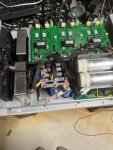Portofino
Well-Known Member
Going back to what’s changed since it ran well , before you “turned it on at sea “ running .
I don’t believe in coincidences or bad luck with new kit or older tried + tested over years kit .
Something has or was changed before it went “ bang “ ….Electrically over all in the boat not just the geny .
What did you do last ? If you can’t arrive at a diagnosis and hope just throwing parts a the problem it’s gonna repeat .
You might or others interested in this thread find this helpful he mentions capacitor going “bang “ ?
I don’t believe in coincidences or bad luck with new kit or older tried + tested over years kit .
Something has or was changed before it went “ bang “ ….Electrically over all in the boat not just the geny .
What did you do last ? If you can’t arrive at a diagnosis and hope just throwing parts a the problem it’s gonna repeat .
You might or others interested in this thread find this helpful he mentions capacitor going “bang “ ?


